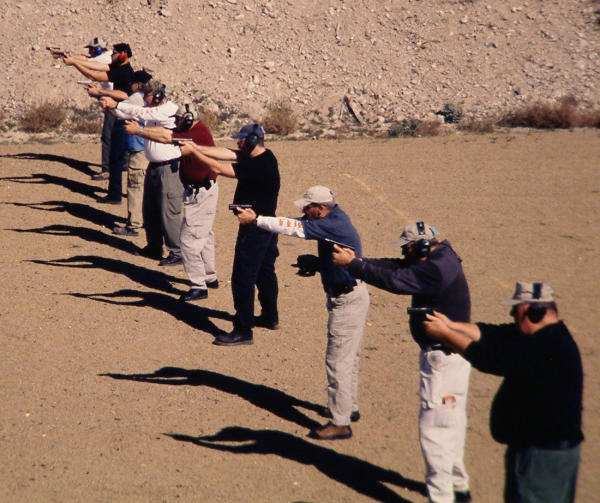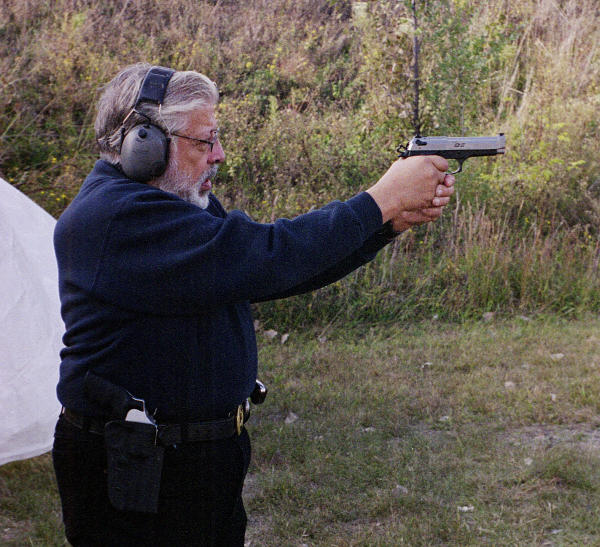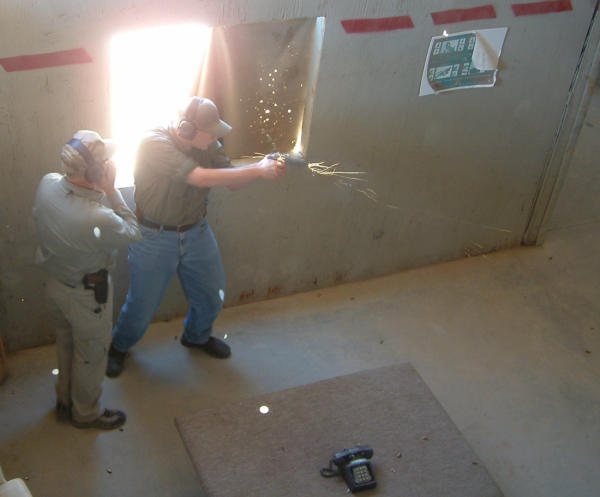Editor’s Note: Today’s guest feature is submitted by the character who taught the rifle section of a law enforcement firearms instructor school in 1986 – a school attended by your editor as a student. He’s also a long-time industry insider.

About a year ago, I attended an inaugural “tactical handgun” shoot for a new club. One of the participants was a young man dressed in BDU’s wearing a drop-thigh holster and military gloves of some sort. He wore a cap with the American Sniper “punisher skull” logo on it and had a goatee that hung down to his magazine vest somewhere between Duck Commander and ZZ Top length. Wrap around “operator” sun glasses covered what I could only assume were steely-cold eyes.
When told to “load and make ready,” he drew his handgun, brought it to center-chest and pushed it straight out into a text-book Isosceles Triangle stance. Taking a quick sight picture on the first target, he brought the gun straight back to center-chest, tilted the gun 45 degrees starboard and smartly inserted a magazine. Racking the slide via a firm sling-shot, he brought the gun back to center-chest and then down into the holster. As he assumed his start position, he lowered his chin, slightly hunched his shoulders and shifted his weight to the balls of his feet causing him to lean toward the first target. He looked like a panther ready to pounce on a gazelle.
When the buzzer went off, he drew the gun back to his center-chest, extended it out into a perfect Isosceles stance and double-tapped the first three targets so quickly that I could hardly count the shots. With his finger straight along the frame, he Groucho-walked in perfect SWAT-conga-line fashion to the barricade at the second and final position and engaged the last three targets at a rate-of-fire that would make Ed McGivern turn green with envy. After the sixth shot, he brought the gun back to center-chest and checked his 6 looking over his right and left shoulders in a tactical genuflect like someone checking to see if anyone behind them noticed that they had just farted.
His unloading sequence was as punctilious as his loading. As we walked to the first bank of targets I asked him what agency or military branch that he had trained with. He said that he worked as a computer tech, wasn’t a veteran and had never taken a class from anyone, but spent a lot of time on You Tube and the internet. I don’t remember his total score but of the six total targets, two had no hits what-so-ever, two had one peripheral hit each and no targets had two “A” hits. The kid was a paragon of protocol and he certainly looked tacti-cool, but couldn’t hit his butt with both hands, but wow, was he fast! Over the past 45 years that I’ve spent shooting competitively, I’ve seen shooters (myself included) respond to poor performance with anger, denial and embarrassment, but this kid had that Hillary-supporter-on-election-night look of disbelief and betrayal.
Apparently YouTube had let him down.
The internet has changed the playing field by allowing anyone with a computer, video camera and a touch of narcissism to immediately be an expert. God bless the 1st Amendment but good theatrics won’t trump talent, experience and common sense. I’m afraid that there’s a whole upcoming generation of Gen X’ers or Millennials whose sole skill is impersonating what they see on You Tube.

One of these cyber-senseis’ videos that I watched decries competitive shooting, with the mantra, “That stuff will get you killed on the street.” Said Guru had apparently participated in a few IPSC events when he finished his covert, overseas ops for the Government, but he came to realize that competition was a Petri dish of lethally bad habits. Certainly the possibility that he wasn’t good enough to be competitive didn’t impact his opinion.
The term “Training Scars” has become the shooting world’s pop-culture-psycho-babble term to degrade anything the trainer doesn’t agree with. “Training Scars” are like “Attention Deficit Disorder,” if they existed 30 years ago, nobody knew about it and the cure seems
worse than the malady (hyper little Johnny likely doesn’t need Ritalin, he needs a spanking).
This discussion usually manifests itself with a comment like “What you do in practice you’ll do in a fight.” Maybe.

Many decades of LEO’s whose only training and practice was on the PPC course, would seem to prove otherwise however. “If you wouldn’t do it in a gun fight, don’t do it when you’re training,” is another bromide that has been applied to such tactics as manually removing your
magazine from your firearm instead of letting it drop out on the ground and even practicing double taps. Somehow I doubt that manually removing my magazine is flirting with committing inadvertent suicide, but the internet guy was pretty dogmatic; it must be true.
I’m guessing that many of these instructors don’t know that in the late 70’s and 80’s, a number of the “high-speed, low-drag” organizations went to the square range, stationary target, static position schools of competitive shooting to learn basic shooting skills! I was fortunate enough to have been in the first class that Ray ever ran at the Chapman Academy. Since I lived close, we became friends and I helped him with a few classes. The Navy SEALs came to
the Chapman Academy to work with Ray. They also went to Berryville to work with Bill Wilson and to MISS to work with John Shaw, two competitive shooters that never ran a black op nor (I’m guessing) heard a shot fired in anger. Apparently all of the square range, static training didn’t get them all killed as they kept coming back.
Don’t get me wrong, the internet can be a wonderful resource. But before you become enamored with Israeli Unchambered Carry Tactics or Center Axis Relock because they look cool online, let me recommend that you take a class on basic shooting and don’t worry about training scars. Don’t be impressed or become gullible due to an instructor’s military or law enforcement credentials. The worst handgun instruction that I ever received was in the Marine Corps and some of the most inept shooters that I’ve ever observed were police officers.
Coaching, training and instructing skills are not issued with badges nor with DD Forms 214.
Turn off the computer, take a class and don’t wait until you feel “comfortable” to enter a USPSA or IDPA match. I guarantee you that that young YouTube commando that I shot with learned more on that Saturday morning match than he had in months of internet matriculation.
Greg Moats was one of the original IPSC Section Coordinators appointed by Jeff Cooper shortly after its inception at the Columbia Conference. In the early 1980’s, he worked briefly for Bianchi Gunleather and wrote for American Handgunner and Guns. He served as a reserve police officer in a firearms training role and was a Marine Corps Infantry Officer in the mid-1970’s. He claims neither snake-eater nor Serpico status but is a self-proclaimed “training junkie.”
